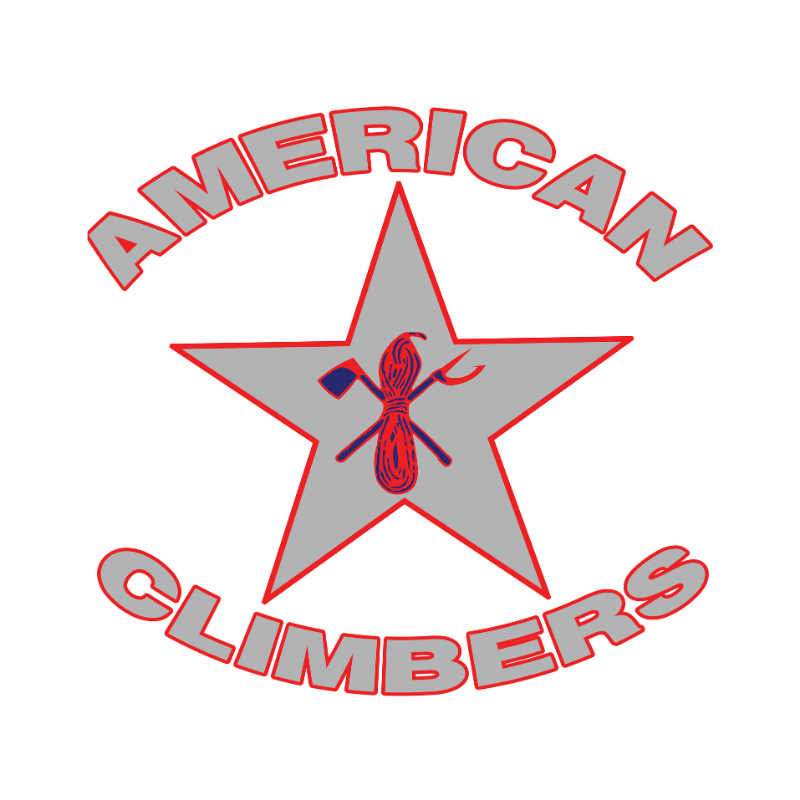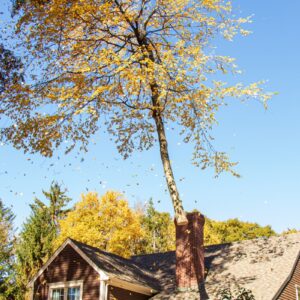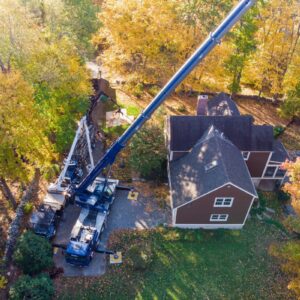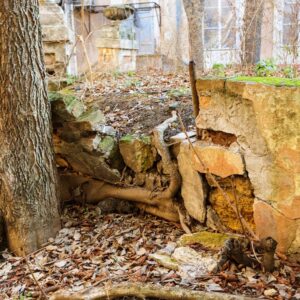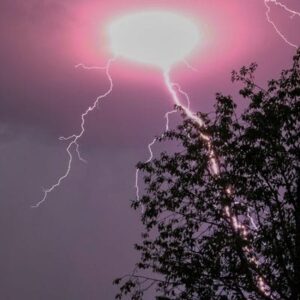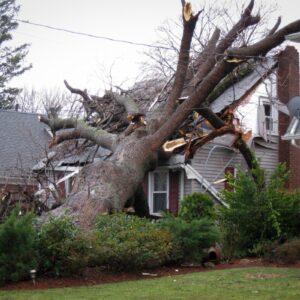The massive storm at the end of 2024 that brought trees down and knocked out power throughout the MetroWest area was a wake-up call for many homeowners. As leaves drop across Weston’s Kendal Common, Sherborn’s historic districts, and Dover’s wooded enclaves, property owners now have their clearest view of potential tree hazards that summer foliage kept hidden.
This annual leaf drop creates a brief but crucial opportunity to identify and remove dangerous trees before winter storms stress already-compromised trees to their breaking point. Taking action now means avoiding emergency situations later.
Key Takeaways
- Fall leaf drop reveals structural defects invisible during summer months, including dead branches, decay, and dangerous lean patterns.
- October through November offers ideal removal conditions with moderate weather and stable ground before winter storms hit.
- MetroWest’s mature tree neighborhoods face unique challenges, including centuries-old trees in Sherborn and dense canopy developments in Weston, which require specialized equipment.
- Professional assessment identifies hazards homeowners often miss, potentially saving thousands in emergency removal and property damage costs.
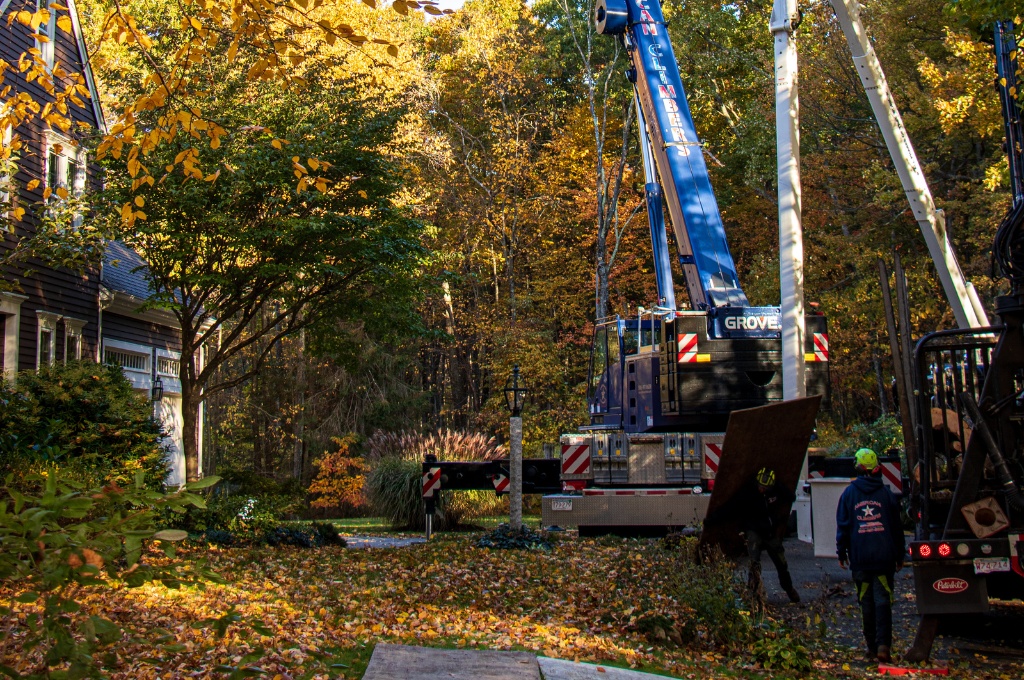
Professional crane-assisted tree removal in MetroWest neighborhoods requires specialized equipment and expertise for safe completion.
Why Fall Is the Best Time for a Tree Risk Assessment
Summer’s thick canopy creates a beautiful green screen that hides serious structural issues. According to UMass Extension’s tree inspection guidelines, many critical defects become visible only when trees are dormant.
When leaves drop in autumn, they take their camouflage with them, revealing problems that may have been developing all year long, including:
- Dead or Dying Branches: Bare twigs and branches stand out sharply against the sky.
- Weak Branch Attachments: Included bark and poor unions are more obvious without foliage
- Internal Decay: Fungal growth, cavities, or hollow sections reveal hidden rot
- Root Problems: surface roots may be exposed, showing girdling or instability near the trunk flare
- Structural Instability: Root plate lifting, cracks at the base, or leaning trunks become more obvious
Distinguishing between dead and dormant trees becomes much easier with bare branches, helping you identify which trees need immediate attention.
WARNING: Dead tree removal becomes a priority when these signs indicate serious safety risks to people and property. Removing these trees requires the expertise of a professional tree removal company.
Why Fall Offers the Best Conditions for Tree Removal
Fall offers ideal working conditions that become complicated once winter arrives:
- Stable ground conditions for heavy equipment like cranes and wood chippers
- Moderate weather allows for safer, more efficient work
- Clear access routes before snow and ice create hazards
- No emergency restrictions that limit when and where removal work can occur during storms
Crane-assisted tree removal is essential in tight developments, like Bolton’s Century Mill Road area or Hopkinton’s Forestside Estates, where winter access becomes problematic after significant snowfall.
The Risks of Skipping a Professional Tree Risk Evaluation
While you can spot obvious issues like hanging branches or visible decay, professional tree risk assessment identifies factors that require training and specialized equipment to detect safely.
Tree care professionals examine:
- Root zones for signs of instability
- Branch attachments for structural integrity
- Species-specific failure patterns that homeowners might miss
- Overall tree health in relation to site conditions and potential storm loading
“Every fall, we get calls from homeowners saying, ‘I never noticed that dead branch until the leaves came down.’ That’s exactly why October and November are perfect for tree evaluation. You can see everything clearly, the weather’s still good for safe removal work, and you’re getting ahead of winter storm season instead of dealing with an emergency later.” – Rich Yurewicz, Owner of American Climbers
Structural Hazards in Historic MetroWest Neighborhoods
Sherborn’s historic districts and Dover’s Chase Woodlands corridor are home to some of MetroWest’s oldest oaks, maples, and pines – trees that have stood for centuries. These mature giants often outgrow their original planting sites and now stand close to irreplaceable homes and historic structures. When structural issues develop, removal or mitigation becomes highly complex, requiring careful evaluation to prevent damage to heritage buildings and landscapes.
Crane Access and Safety Issues in Tree-Dense Developments
In Weston’s Kendal Common and Spruce Hill neighborhoods, preserved mature trees add privacy and character but create challenges for removal. Tight spacing between homes means crane access is often required to handle large specimens safely. Similarly, Hopkinton’s Forestside Estates, built in the 1990s, features custom homes tucked into heavily wooded lots.
Here, large trees provide beauty and seclusion but also pose risks during storms. Access is further complicated by the development’s proximity to conservation land, which limits equipment options and requires professional planning.
Property and Municipal Overlap with Street Trees
Framingham’s established North Side neighborhoods highlight another challenge: the interaction between municipal street trees and private property trees. When hazardous branches extend over public rights-of-way or border municipal land, resolving risks often requires coordination with local authorities. A professional tree risk evaluation ensures that both property owners and municipalities understand their responsibilities, preventing liability disputes while keeping neighborhoods safe.

Fall provides optimal conditions for positioning heavy equipment needed for safe hazardous tree removal in MetroWest.
What Arborists See That Homeowners Overlook
Professional tree risk assessment goes far beyond spotting obvious problems. Tree care experts use systematic evaluation methods that examine:
- Crown structure, including branch distribution and attachment points
- Trunk integrity using specialized tools to test wood soundness
- Root zone stability by evaluating soil conditions and root health
- Site factors like drainage, wind exposure, and nearby structures
- Species-specific risks based on failure patterns and growth characteristics
This comprehensive evaluation generates the necessary documentation for insurance claims, municipal permits, and legal liability protection that DIY inspections cannot provide.
Frequently Asked Questions About Hazardous Tree Inspections
When is the best time to remove hazardous trees?
The best time to remove a hazardous tree is between October and November, when moderate weather and stable ground offer easier access for our heavy equipment. Winter removal works when the ground is frozen, but emergency winter storm removal is more dangerous and expensive than planned removal.
Can I identify hazardous trees myself?
You can spot obvious problems, like dead branches, visible decay, or extreme lean. However, professional assessment is needed to evaluate root stability, internal decay, and structural defects that require specialized knowledge. Dead tree removal involves serious safety risks that make professional evaluation essential.
What makes a tree “hazardous” vs. just unsightly?
Hazardous trees have structural defects that create failure potential, such as significant dead wood, root damage, trunk decay, or dangerous lean patterns. Knowing when to remove a tree versus attempting to save it requires professional evaluation. Certain tree species are more prone to storm failure than others.
Do I need permits for hazardous tree removal?
Permit requirements vary by municipality in the MetroWest. Some towns require permits for trees over certain sizes or within designated areas. Professional tree services help navigate permit requirements and can handle applications on your behalf.
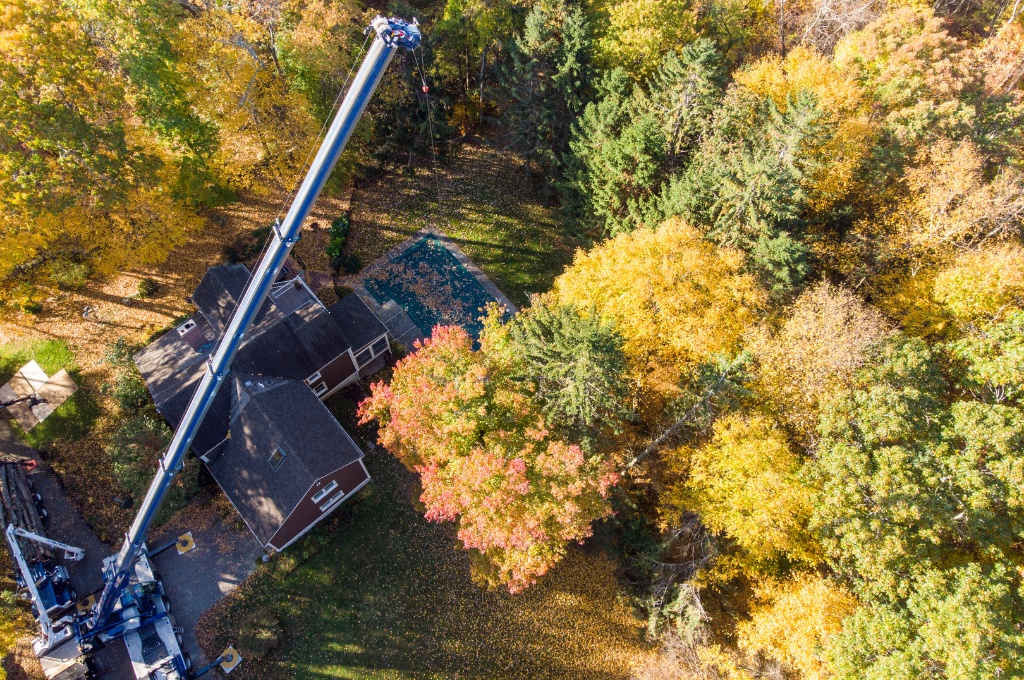
After you discover a hazardous tree in the fall, it’s the perfect time to remove the tree for safety.
Don’t Wait for Winter Storm Season, Remove Your Hazardous Trees Today!
Fall’s brief window for safe hazardous tree removal is closing fast. American Climbers has specialized equipment, including cranes and grapple saws, plus nearly 30 years of experience handling challenging removals in MetroWest’s tree-dense neighborhoods. We’re fully insured, locally owned, and offer discounts for veterans.
Call American Climbers today at 508-497-8628 or request a quote online for hazardous tree removal. Protect your property before winter storms turn a manageable situation into a dangerous emergency.
Blog Topics
Recent Posts
What's Happening? Stay Informed!
Stay on top of local events, pest and disease updates, tree and landscape tips, and more. Delivered straight to your inbox each month.
